Erin Murray’s “Space to Fill”
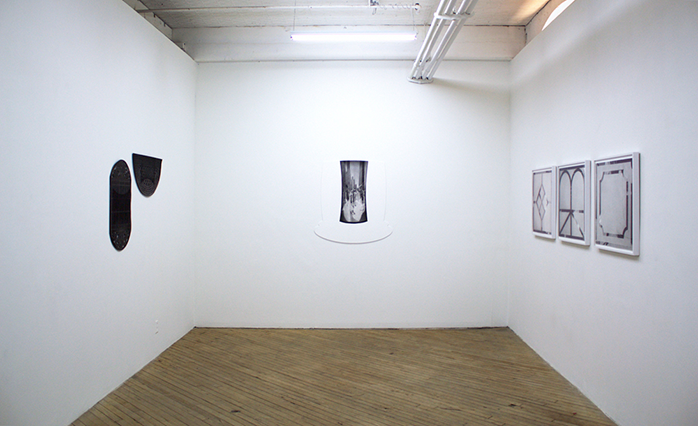
(IMAGE: Installation view of Space to Fill. CREDIT: Courtesy of the artist)
CHRISTOPHER GIANUNZIO: Can you begin by talking a little about your background and the foundation of your process?
ERIN MURRAY: My work has always been at its heart an exploration of landscape and usually references my current surroundings and things I see repetitively. What elements I choose to examine has changed through time, but my basic desire is to transcribe that experience for the viewer, by creating something novel that is informed by my own experiences and feelings about what I see, and in that process usually gaining a deeper understanding of my subjects and my own motivations.
My father is a builder/self-taught architect who successfully designed and built just one building — a circular one — in which I grew up in during the nineties. I would point to that person and experience as the most formative in my practice and in the creation of my identity as an artist and maker. My last show at Vox, Dream House, actually explored that relationship in exhibit form. In life as well as in art I am engaged with the built environment, having spent years on a large renovation project and making my living in part as a landlord. Also, one can’t have lived in Philadelphia for the past 15 years without internalizing the sticky politics of its rapid development. All of these things have informed my art practice, which in general attempts to enforce an empathetic connection to the things we build.
CG: Your work is strongly engaged with architecture and ornamental domestic forms, how do you see your process engaging with these moments in time and space?
EM: I think my work usually takes these forms out of time and space, referencing them in more of an idealized, timeless and airless manner, similar to a traditional architectural rendering, where function is secondary to form. This allows for a broadness of interpretation, a way that the viewer can see the form as both coming from a specific place but also something that can be mapped onto or hold a bigger meaning.
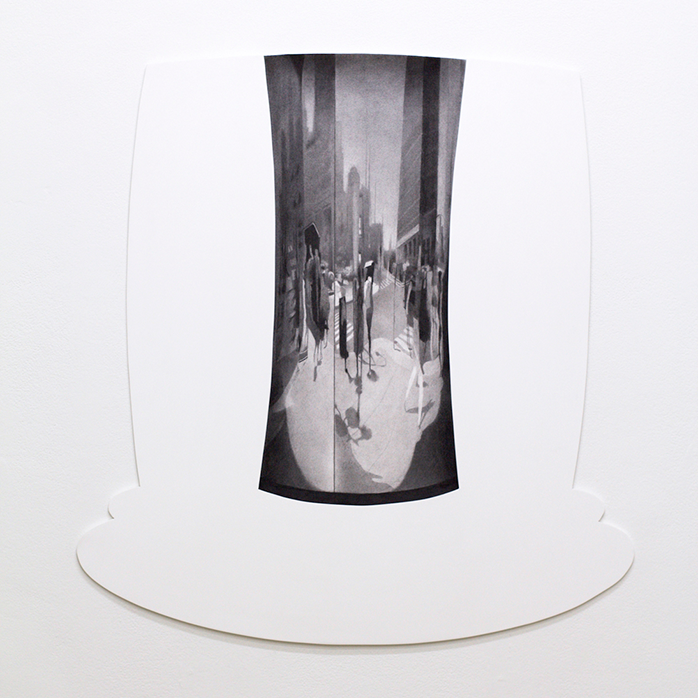
(IMAGE: Allswell, graphite on paper with Sintra frame, 37″x 35 1/2″, 2015. CREDIT: Courtesy of the artist)
CG: How does the act of drawing satisfy something that photography cannot provide when making this kind of work? Do you feel that there is a kind of photographic approach to your process?
EM: Drawing usually rewards me with a greater understanding of my subject; in the same way that drawing a figure teaches you about skeletal structure, but also in a time-spent kind of way.
I am very attracted to certain trends in contemporary photography that I do think relate to my own work; a kind of juxtaposition of realism and abstraction, consensus and dissensus, that offers a satisfying cognitive dissonance.
With the current body of work in Space to Fill, I spent a great deal of time and a few different strategies in trying to bridge that gap; to have the open possibilities of abstraction without relinquishing the richness and authority of realism. In both Allswell and Chatterbox, I brought to full resolution a less-than-perfect photographic reference. The resulting distortions both expose a lack of information at hand and introduce a sense of mystery, intrigue and absurdity to the image. Here I’m trying to capture some of what attracted me to depicting the built environment in the first place (and an unfortunate a casualty of my practice and experience); basically an endless series of what-the-fuck moments coupled with a lack of knowledge about whence they came. I’m trying to push the work beyond a cherry-picking display of these kinds of things and more towards self-sufficiency as art; and so far the medium of drawing has allowed me both the familiarity and freedom to do that.
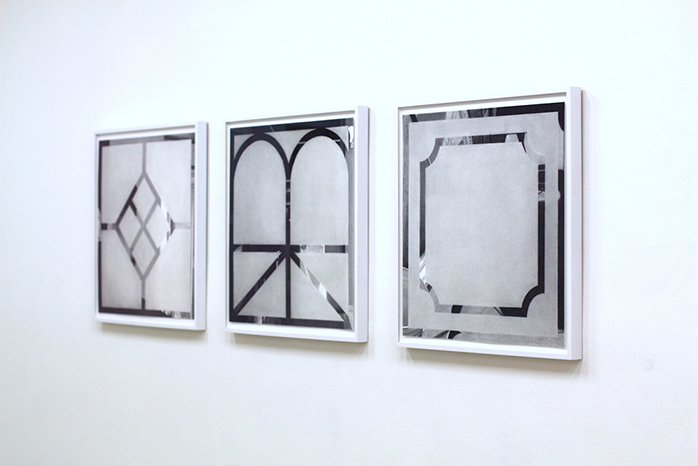
(IMAGE: Tilted Crossbuck, Mock Tudor, Single Provincial, (each) 25 1/2″x 25″, graphite on paper, 2015. CREDIT: Courtesy of the artist)
CG: How much of your work and process engages with idealized and/or actual perception of social spaces?
EM: Well, I’m trying to present non-ideal places in an idealized way, in an attempt to shift an expected, probably negative, attitude to something more accepting, open, and playful. We are surrounded by thoughtless design, flat dumbness, awkward decisions, and numbing sameness. How do we find a way to live with these things while actually looking at them? Many people find ways to selectively ignore, but I think it’s best to just fold them into the things we like, as pollyanna-ish as that sounds. With Space to Fill, I focused on elements within the environment that represent a kind of inartful, habitual design, taking the premise that these things must embody both historical and conferred meaning despite their apparent emptiness and therefore deserve a great deal of consideration.
CG: What are some things that you look to outside of the art world for inspiration?
EM: Some architectural writers have been informative to me. I generally am never looking at capital “A” architecture within my work, but certainly there’s some overlap, especially when discussed in the theoretical realm. Sam Jacob is an architect based in England who has written extensively about the idea of “architecture as enactment”, our tendency in design to reenact what has come before, which he theorizes as a way we have come to cope with our unnatural surroundings. I continue to be fascinated by this huge whisper-down-the-lane experiment of human nature; how an apparently innate conservatism can result in the awesomely absurd and other ways in which our designed structures betray our humanness.
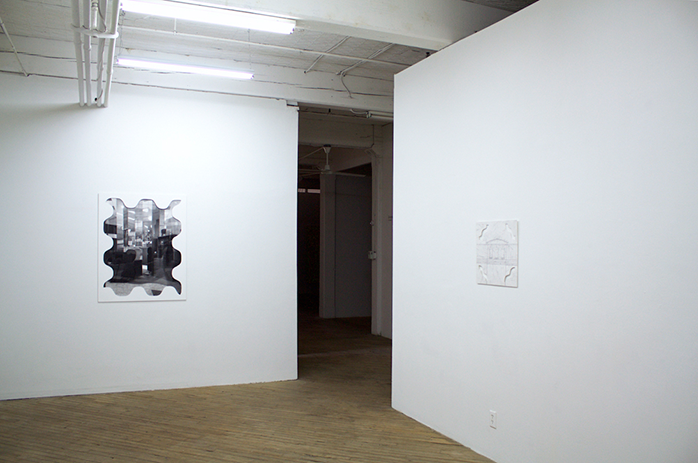
(IMAGE: Installation view of Space to Fill. CREDIT: Courtesy of the artist)
CG: What is next for you?
EM: Look out for a print run of some of my recent work, in collaboration with Space 1026 artist Justin Myer Staller.
CG: When we were talking at your show you mentioned that you are interested in a kind of “filler space” in architecture, where design elements are added in order to accent space as a means to make a building more attractive, what about those moments in space do you find fascinating?
EM: For this show in particular I spent a lot of time considering the non-functional aspects of buildings: the fillers, the finishes, the parts meant to animate something blank. It’s here where you find some of our lamest design efforts, my favorite kind. (I should mention that I look mostly at vernacular or commercial type buildings, not design that is highly considered or singular.) These days the decorative elements on a building are largely unrelated to the structural elements, so it’s up to the designer or builder to choose from a grab bag of design decisions of the past to finish an exterior. In that way, there is kind of a parallel to a 2D art practice which is interesting, but more than that there is a physical representation of that choice that remains stuck in its time, and will forever (well, until it is demolished) tell us a little something about who made it, when, what was prioritized or not, etc.
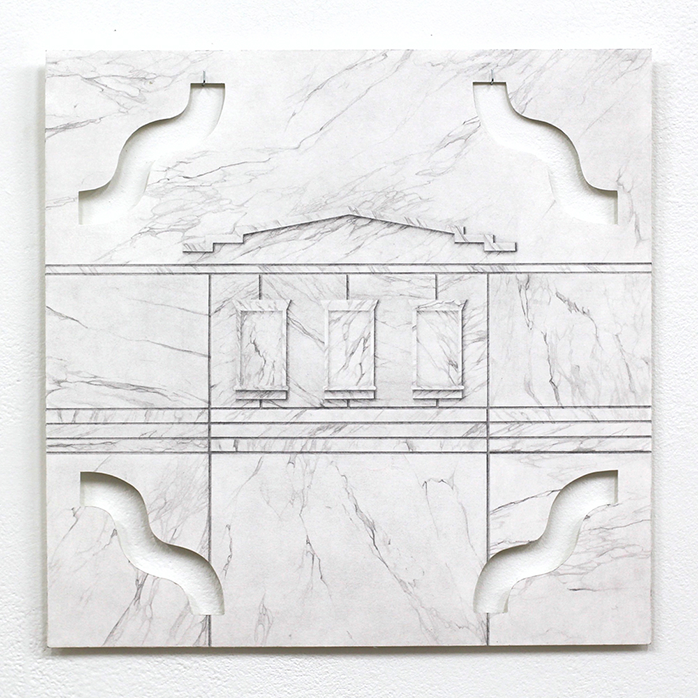
(IMAGE: Space to Fill, graphite on paper, 18″ x 18″, 2015. CREDIT: Courtesy of the artist)
CG: Could you explain the idea of the ready-made as it relates to your work? I am thinking of the door-mat work in the exhibition.
EM: It’s not a way in which I usually work, but one day I was walking around, thinking about filler space, looking at buildings, and thinking of how to distill such things into artwork. Looking down, I saw a doormat. It seemed to have within it a variety of our favorite ways to thoughtlessly fill space; a grid, a floral motif, some fake stones. There it was, framed and ready to go, an item that lived in the realm of buildings, something you could buy at Home Depot, something even related to the body in the same way that a building is. I did two doormat drawings to exact scale, intervening just a bit with shading to enhance a kind of tragi-comic-facial quality that existed between the two. Vertically oriented, the one looks a bit like a mirror. Yes, I want you to look at a couple of doormats and maybe see yourself. And laugh!
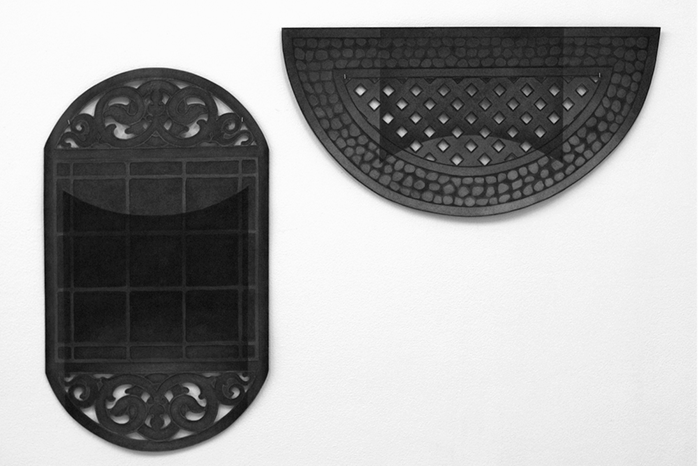
(IMAGE: Stand On / Stand In, graphite and india ink on paper, 29 1/2″ x 17″, 14 1/2″ x 29″, 2015 CREDIT: Courtesy of the artist)
Christopher Gianunzio is an artist and curator based in Philadelphia and is currently the Director of the Art Gallery and the Sarnoff Collection at the College of New Jersey. He has organized exhibitions including the work of Adam Broomberg & Oliver Chanarin, Alyse Emdur, La Toya Ruby Frazier, Luis Gispert, Beate Gütschow, Greg Halpern, Ron Jude, Christian Patterson, Taryn Simon, Chad States, Mark Steinmetz and Ofer Wolberger. Previously he worked as the Assistant Director of the Philadelphia Photo Arts Center where he founded the Philadelphia Art Book Fair. He is currently a member of Vox Populi.
…
Erin Murray: Space to Fill
erinmurray.org
ON VIEW: November 6-29, 2015
Vox Populi
319 North 11th Street, 3rd Floor
Philadelphia, PA 19107
voxpopuligallery.org
